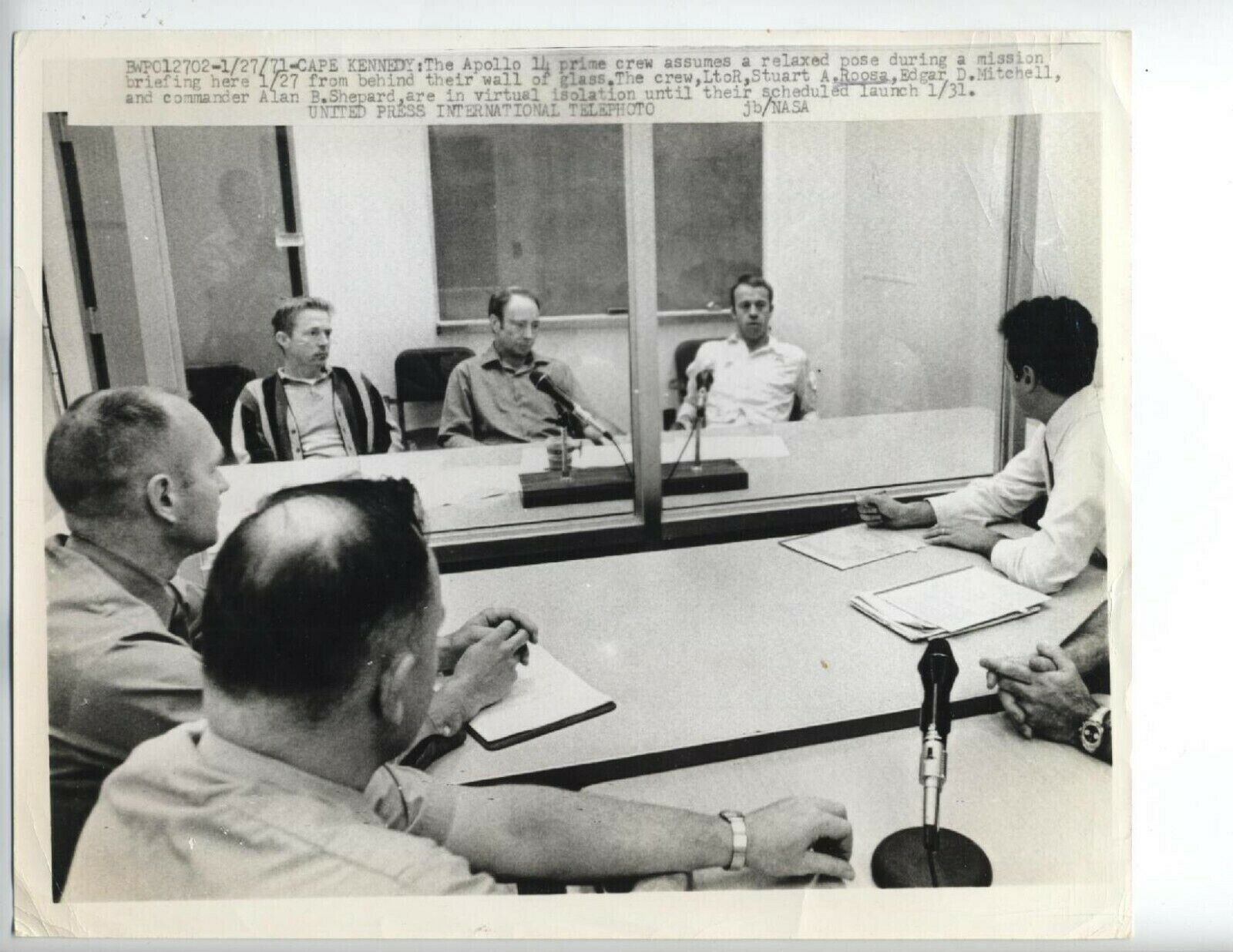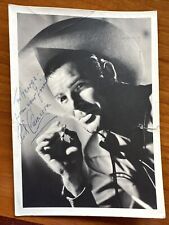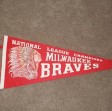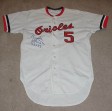When you click on links to various merchants on this site and make a purchase, this can result in this site earning a commission. Affiliate programs and affiliations include, but are not limited to, the eBay Partner Network.
8x10 inch vintage original Cape Kennedy1971 Press Photo Apollo 14 featuring Astronauts Stuart Roosa, Alan Shepard, Edgar Mitchell
Apollo 14Apollo 14 official mission patchThis is the Apollo 14 crew patch designed by astronauts Alan B. Shepard Jr., commander; Stuart A. Roosa, command module pilot; and Edgar D. Mitchell, lunar module pilot. It features the astronaut lapel pin approaching the moon and leaving a comet trail from the liftoff point on Earth.Credits: NASA"Shepard back in space..."
Mission ObjectiveThe primary objectives of this mission were to explore the Fra Mauro region centered around deployment of the Apollo Lunar Surface Scientific Experiments Package, or ALSEP; lunar field geology investigations; collection of surface material samples for return to Earth; deployment of other scientific instruments not part of ALSEP; orbital science involving high-resolution photography of candidate future landing sites; photography of deep-space phenomena, such as zodiacal light and gegenschein; communications tests using S-band and VHF signals to determine reflective properties of the lunar surface; engineering and operational evaluation of hardware and techniques; tests to determine variations in S-band signals; and photography of surface details from 60 nautical miles in altitude.
Mission HighlightsApollo 14 launched at 4:03 p.m. EST. At approximately 3:41 p.m. ground elapsed time, or GET, difficulties were experienced in docking with the lunar module, or LM, and six attempts were required before a "hard dock" was achieved. An in-flight televised inspection of the docking mechanism revealed no apparent reason for the malfunction and the system appeared to be functioning normally.Prior to the powered descent initiation, or PDI, for the Antares landing, a short in the LM computer abort switch was discovered, which could have triggered an undesired abort during the LM's descent. On Feb. 5, Antares made the most precise landing to date, approximately 87 feet from the targeted landing point. The landing point coordinates were 3 degrees, 40 minutes, 27 seconds south and 17 degrees, 27 minutes, 58 seconds west, midway between the Doublet and Triplet craters in the hilly uplands of the Fra Mauro crater, and about 110 miles east of the Apollo 12 landing site.
Due to communications system problems, the first period of extra vehicular activity, or EVA, began almost one hour later than scheduled with Commander Alan Shepard setting foot on the lunar surface at 114 hours, 31 minutes GET. The first of the two EVA periods included ALSEP deployment and lasted four hours, 49 minutes.
The second EVA on Feb. 6 began when the LM egress hatch was opened at 4:15 a.m. EST. During this EVA, Shepard and Edgar Mitchell moved more than half a mile from their LM, conducting selenological investigations, collecting samples and attempting to reach the rim of Cone crater, approximately 300 feet above the landing site. NASA personnel monitoring the EVA estimate that the two astronauts were within 50 to 75 meters of the crater rim when they were advised by mission control to collect samples at that spot and begin their traverse back to the LM. The second EVA lasted four hours, 35 minutes, resulting in a new mark for EVA time by a lunar landing crew: nine hours, 24 minutes. Shepard set a new distance-traveled record on the lunar surface of approximately 9,000 feet.
During the two traverses, the astronauts collected 94 pounds of rocks and soil for return to Earth. The samples were scheduled to go to 187 scientific teams in the United States, as well as 14 other countries for study and analysis.
Orbital science activities were conducted by Stuart Roosa during the lunar surface activities period. He experienced some difficulties with the high-resolution, motion-compensating Hycon Lunar Topographic Camera while attempting to photograph the Descartes area, the landing site planned for Apollo 16.
The liftoff of Antares from the lunar surface took place precisely on schedule. Rendezvous and docking occured only two minutes later than scheduled. The command module Kitty Hawk splashed down safely in the Pacific Ocean at 4:05 p.m. EST Feb. 9, exactly nine days and two minutes after launch. The actual landing point was only 1.02 nautical miles off its targeted point of about 765 nautical miles south of Samoa, and four miles from the prime recovery ship, the USS New Orleans. The mission duration from liftoff to splashdown was 216 hours, two minutes.
CrewAlan B. Shepard Jr., CommanderEdgar D. Mitchell, Lunar Module PilotStuart A. Roosa, Command Module Pilot
Backup CrewEugene A. Cernan, CommanderJoe H. Engle, Lunar Module PilotRonald E. Evans, Command Module Pilot
PayloadKitty Hawk (CM-110)Antares (LM-8)
Prelaunch Milestones1/21/70 - S-IVB ondock at Kennedy1/21/70 - S-II ondock at Kennedy1/12/70 - S-IC ondock at Kennedy5/6/70 - S-IU ondock at Kennedy
LaunchJan. 31, 1971; 4:03 p.m. EDTLaunch Pad 39ASaturn-V AS-509High Bay 3Mobile Launcher Platform-2Firing Room 2
OrbitAltitude: 118.55 milesInclination: 31.12 degreesOrbits: 34 revolutionsDuration: nine days, two minutesDistance: 1,150,321 milesLunar Location: Fra MauroLunar Coordinates: 3.65 degrees south, 17.48 degrees west
LandingFeb. 9, 1971Pacific OceanRecovery Ship: USS New Orleans
Last Updated: Jan. 9, 2018Editor: NASA Content Administrator
APOLLO 14 (AS-509)The Third Manned Lunar LandingApollo 14 Liftoff
Alan Shepard (Apollo 14)
Apollo 14 landed in the Fra Mauro region, the intended landing site of the aborted Apollo 13 mission. The astronauts used the Modularized Equipment Transporter (MET) to haul equipment during two EVAs (later missions would use the Lunar Roving Vehicle). They collected samples, took photographs, and the nearby Cone crater. One of the more famous moments came at the end of the second EVA when Apollo 14 commander Alan Shepard hit 2 golf balls on the Moon.
Summary of EventsThe Apollo 14 mission was the third manned lunar landing mission. Its objective was to perform detailed scientific lunar exploration. The space vehicle with a crew of Alan B. Shepard, Jr., the commander; Stuart A. Roosa, the command module pilot; and Edgar D. Mitchell, the lunar module pilot, was launched from Kennedy Space Center, Fla., at 4:03:22 EST on January 31, 1971.
The touchdown occurred at 08:37:10 GMT, February 5, within 50m (160 ft) of the target point in the Fra Mauro highlands. The first extravehicular activity (EVA) began 5 hr 23 min after touchdown.
A color television camera mounted on the descent stage provided live coverage of the descent of both astronauts to the lunar surface. The crew deployed the U.S. flag and and the solar-wind composition experiment, erected the S-band antenna, and off-loaded the modularized equipment transporter (MET), laser ranging retroreflector (LRRR), and the Apollo lunar-surface experiments package (ALSEP).
The second EVA was a planned extended geological traverse of Cone Crater. All equipment required for the geological traverse, including the lunar portable magnetometer (LPM), was loaded on the MET. The traverse up the side of Cone Crater provided experience in climbing and working in hilly terrain in 1/6 earth gravity conditions. This EVA lasted 4 hr and 20 min, during which time the astronauts traveled approximately 3 km.
Liftoff occurred at 18:48 GMT, February 6, after 33 hr on the lunar surface. After crew transfer, the LM ascent stage was separated and remotely guided to impact on the lunar surface. Impact occurred between Apollo 12 and 14 seismometers. The resulting seismic signal lasted for 1.5 hr and was recorded by both instruments.
The command module splashed down in the Pacific Ocean approximately 1 km from the target point at 20:24 GMT, February 9, 1971. From NASA SP-272, Apollo 14 Preliminary Science Report.Apollo 14 was the eighth crewed mission in the United States Apollo program, the third to land on the Moon, and the first to land in the lunar highlands. It was the last of the "H missions," targeted landings with two-day stays on the Moon with two lunar EVAs, or moonwalks.
Commander Alan Shepard, Command Module Pilot Stuart Roosa, and Lunar Module Pilot Edgar Mitchell launched on their nine-day mission on Sunday, January 31, 1971, at 4:03:02 p.m. EST. Liftoff was delayed forty minutes and two seconds, due to launch site weather restrictions, the first such delay in the Apollo program.[4]
Shepard and Mitchell made their lunar landing on February 5 in the Fra Mauro highlands – originally the target of the aborted Apollo 13 mission. During the two lunar EVAs, 94.35 pounds (42.80 kg) of Moon rocks were collected,[5] and several scientific experiments were performed. Shepard hit two golf balls on the lunar surface with a makeshift club he had brought with him. Shepard and Mitchell spent 331⁄2 hours on the Moon, with almost 91⁄2 hours of EVA.
In the aftermath of Apollo 13, several modifications had been made to the service module electrical power system to prevent a repeat of that accident, including a redesign of the oxygen tanks and the addition of a third tank. The launch had been scheduled for October 1, 1970,[6] and was delayed about four months.[7]
While Shepard and Mitchell were on the surface, Roosa remained in lunar orbit aboard the command and service module Kittyhawk,[8] performing scientific experiments and photographing the Moon, including the landing site of the future Apollo 16 mission. He took several hundred seeds on the mission, many of which were germinated on return, resulting in the so-called Moon trees.
Shepard and Mitchell successfully lifted Antares off the Moon to dock with the command module and, after a total of 34 lunar orbits,[9] the ship was flown back to Earth where the three astronauts landed in the Pacific Ocean on February 9.Contents1 Astronauts and key Mission Control personnel1.1 Backup crew2 Mission parameters2.1 LM–CSM docking2.2 EVAs3 Mission highlights3.1 Launch and flight to lunar orbit3.2 Lunar descent3.3 Lunar surface operations3.3.1 Apollo 14 lunar samples3.4 Return, splashdown and quarantine4 Mission insignia5 Spacecraft locations6 Gallery7 See also8 References9 Bibliography10 External linksAstronauts and key Mission Control personnelPosition AstronautCommander Alan B. Shepard Jr.Second and last spaceflightCommand Module Pilot Stuart A. RoosaOnly spaceflightLunar Module Pilot Edgar D. MitchellOnly spaceflightShepard was the oldest U.S. astronaut when he made his trip aboard Apollo 14.[10][11] He is the only astronaut from Project Mercury (the original Mercury Seven astronauts) to reach the Moon. Another of the original seven, Gordon Cooper, had (as Apollo 10's backup commander) tentatively been scheduled to command the mission, but according to author Andrew Chaikin, his casual attitude toward training, along with problems with NASA hierarchy (reaching all the way back to the Mercury-Atlas 9 flight), resulted in his removal.
The mission was a personal triumph for Shepard, who had battled back from Ménière's disease which grounded him from 1964 to 1968. He and his crew were originally scheduled to fly on Apollo 13, but in 1969 NASA officials switched the scheduled crews for Apollos 13 and 14. This was done to allow Shepard more time to train for his flight, as he had been grounded for four years.[12]
Backup crewPosition AstronautCommander Eugene A. CernanCommand Module Pilot Ronald E. Evans Jr.Lunar Module Pilot Joe H. EngleThe backup crew (with Harrison Schmitt replacing Engle)would become the prime crew of Apollo 17.During projects Mercury and Gemini, each mission had a prime and a backup crew. Apollo 9 commander James McDivitt believed meetings that required a member of the flight crew were being missed, so for Apollo a third crew of astronauts was added, known as the support crew.[13] Usually low in seniority, support crew members assembled the mission's rules, flight plan, and checklists, and kept them updated;[14][15] for Apollo 14, they were Philip K. Chapman, Bruce McCandless, II, William R. Pogue, and C. Gordon Fullerton.[16]
For Apollo 14, flight directors were: Pete Frank, Orange team; Glynn Lunney, Black team; Milt Windler, Maroon team and Gerry Griffin, Gold team.
Mission parametersGeocentric:
Mass: CSM 64,463 pounds (29,240 kg); LM 33,651 pounds (15,264 kg)Perigee: 114 miles (183 km)Apogee: 117 miles (188 km)Orbital inclination: 31.12°Orbital period: 88.18 minSelenocentric:
Periselene: 67 miles (108 km)Aposelene: 195 miles (314 km)Orbital inclination: °Orbital period: 120 minLanding Site: 3.64530° S – 17.47136° W or3° 38' 43.08" S – 17° 28' 16.90" WLM–CSM dockingUndocked: February 5, 1971 – 04:50:43 UTCDocked: February 6, 1971 – 20:35:42 UTCEVAsEVA 1Start: February 5, 1971, 14:42:13 UTCShepard – EVA 1Stepped onto Moon: 14:54 UTCLM ingress: 19:22 UTCMitchell – EVA 1Stepped onto Moon: 14:58 UTCLM ingress: 19:18 UTCEnd: February 5, 19:30:50 UTCDuration: 4 hours, 47 minutes, 50 secondsEVA 2Start: February 6, 1971, 08:11:15 UTCShepard – EVA 2Stepped onto Moon: 08:16 UTCLM ingress: 12:38 UTCMitchell – EVA 2Stepped onto Moon: 08:23 UTCLM ingress: 12:28 UTCEnd: February 6, 12:45:56 UTCDuration: 4 hours, 34 minutes, 41 secondsMission highlights
Launch of Apollo 14Launch and flight to lunar orbitApollo 14 launched during heavy cloud cover and the Saturn V booster quickly disappeared from view. NASA's long-range cameras, based 60 miles south in Vero Beach, had a clear shot of the remainder of the launch. Following the launch, the Launch Control Center at Kennedy Space Center was visited by U.S. Vice President Spiro T. Agnew, Prince Juan Carlos of Spain, and his wife, Princess Sofía.
At the beginning of the mission, the Apollo CSM Kittyhawk had difficulty achieving capture and docking with the LM Antares. Repeated attempts to dock went on for 1 hour and 42 minutes, until it was suggested that Roosa hold Kittyhawk against Antares using its thrusters, then the docking probe would be retracted out of the way, hopefully triggering the docking latches. The sixth attempt was successful, and no further docking problems were encountered during the mission.
Lunar descentAfter separating from the command module in lunar orbit, the LM Antares had two serious problems. First, the LM computer began getting an ABORT signal from a faulty switch. NASA believed the computer might be getting erroneous readings like this if a tiny ball of solder had shaken loose and was floating between the switch and the contact, closing the circuit. The immediate solution – tapping on the panel next to the switch – did work briefly, but the circuit soon closed again. If the problem recurred after the descent engine fired, the computer would think the signal was real and would initiate an auto-abort, causing the ascent stage to separate from the descent stage and climb back into orbit. NASA and the software teams at the Massachusetts Institute of Technology scrambled to find a solution. The software was hard-wired, preventing it from being updated directly. The fix involved indicating that abort mode was already active, so that if the signal were to arise again, it would be ignored rather than initiating what would have appeared to the software to be a second abort.[17] The software modifications were transmitted to the crew via voice communication, and Mitchell manually entered the changes (amounting to over 80 keystrokes on the LM computer pad) just in time.[18]
A second problem occurred during the powered descent, when the LM landing radar failed to lock automatically onto the Moon's surface, depriving the navigation computer of vital information on the vehicle's altitude and vertical descent speed (this was not a result of the modifications to the ABORT command; rather, the post-mission report indicated it was an unrelated bug in the radar's operation). After the astronauts cycled the landing radar breaker, the unit successfully acquired a signal near 18,000 feet (5,500 m), again just in time. Shepard then manually landed the LM closer to its intended target than any of the other five Moon landing missions. Mitchell believed Shepard would have continued with the landing attempt without the radar, using the LM inertial guidance system and visual cues. A post-flight review of the descent data showed the inertial system alone would have been inadequate, and the astronauts probably would have been forced to abort the landing as they approached the surface.
Lunar surface operations
The plaque left on the Moon by Apollo 14Shepard and Mitchell named their landing site Fra Mauro Base, and this designation is recognized by the International Astronomical Union (depicted in Latin on lunar maps as Statio Fra Mauro).
Shepard's first words, after stepping onto the lunar surface were, "And it's been a long way, but we're here." Unlike Neil Armstrong on Apollo 11 and Pete Conrad on Apollo 12, Shepard had already stepped off the LM footpad and was a few yards away before he spoke.
Shepard's moonwalking suit was the first to utilize red stripes on the arms and legs and on the top of the lunar EVA sunshade "hood," so as to allow easy identification between the commander and LM pilot on the surface;[19] on the Apollo 12 pictures, it had been almost impossible to distinguish between the two crewmen, causing a great deal of confusion. This feature was included on Jim Lovell's Apollo 13 suit; because no landing was made on that mission, Apollo 14 was the first to make use of it. This feature was used for the remaining Apollo missions, and for the EVAs of Space Shuttle flights afterwards, and it is still in use today on both the U.S. and the Russian space suits on the International Space Station.The "Big Bertha" rock (Lunar Sample 14321) was the third largest rock collected during the Apollo program. In 2019, it was discovered that this is the oldest known rock from Earth, four billion years old.[20]After landing in the Fra Mauro formation—the destination for Apollo 13—Shepard and Mitchell took two moonwalks, adding new seismic studies[21] to the by now familiar Apollo Lunar Surface Experiments Package (ALSEP), and using the Modular Equipment Transporter (MET), a pull-cart for carrying equipment and samples, nicknamed "lunar rickshaw". Roosa, meanwhile, took pictures from on board command module Kittyhawk in lunar orbit.Map of the first and second EVAsThe second moonwalk, or EVA, was intended to reach the rim of the 1,000-foot (300 m) wide Cone crater. The two astronauts were not able to find the rim amid the rolling terrain of the crater's slopes. They became physically exhausted from the attempt and, with their suits' oxygen supplies starting to run low, the effort was called off. Later analysis using the pictures they took determined that they had come within an estimated 65 feet (20 m) of the crater's rim. Images from the Lunar Reconnaissance Orbiter (LRO) show the tracks of the astronauts and the MET come to within 30 m of the rim.[22]
Shepard and Mitchell deployed and activated various scientific instruments and experiments and collected almost 100 pounds (45 kg) of lunar samples for return to Earth, including the 20 pound (9 kg) Big Bertha rock. Other Apollo 14 achievements included the only use of MET; longest distance traversed by foot on the lunar surface; first use of shortened lunar orbit rendezvous techniques; and the first extensive orbital science period conducted during CSM solo operations.Lunar surface television showing Shepard taking a couple of golf swingsThe astronauts also engaged in less serious activities on the Moon. Shepard brought along a six iron golf club head which he could attach to the handle of a lunar excavation tool, and two golf balls, and took several one-handed swings (due to the limited flexibility of the EVA suit). He exuberantly exclaimed that the second ball went "miles and miles and miles" in the low lunar gravity, but later estimated the distance as 200 to 400 yards (180 to 370 m). Mitchell then threw a lunar scoop handle as if it were a javelin.
Apollo 14 lunar samples
Apollo 14 lunar module pilot Edgar Mitchell and commander Alan Shepard analyzing Big Bertha while in the laboratory
Lunar sample 14053, a basalt found during Apollo 14The Moon rocks, or lunar samples, from Apollo 14 are unique in that most of the 94 pounds of rocks are breccia, which are rocks composed of fragments of other, older rocks. Breccias form when the heat and pressure of meteorite impacts fuse small rock fragments together. There were a few basalts that were collected in this mission in the form of clasts (fragments) in breccia. The Apollo 14 basalts are generally richer in aluminum and sometimes richer in potassium than other lunar basalts. Most lunar mare basalts collected during the Apollo program were formed from 3.0 to 3.8 billion years ago. The Apollo 14 basalts were formed 4.0 to 4.3 billion years ago, older than the volcanism observed at any of the mare locations studied during the Apollo program.[23]
In January 2019 research showed that Big Bertha, a 19.837 pound rock, has numerous characteristics that make it likely to be a terrestrial (Earth) meteorite. Granite and quartz, which are commonly found on Earth but very rare to find on the Moon, were confirmed to exist on Big Bertha. To find the sample's age, the research team from Curtin University looked at bits of the mineral zircon embedded in its structure. "By determining the age of zircon found in the sample, we were able to pinpoint the age of the host rock at about four billion years old, making it similar to the oldest rocks on Earth," researcher Alexander Nemchin said, adding that "the chemistry of the zircon in this sample is very different from that of every other zircon grain ever analyzed in lunar samples, and remarkably similar to that of zircons found on Earth." This means Big Bertha is both the first discovered terrestrial meteorite and the oldest known Earth rock.[24][25]
Return, splashdown and quarantine
Apollo 14 landingOn the way back to Earth, the crew conducted the first U.S. materials processing experiments in space.
The command module Kittyhawk splashed down in the South Pacific Ocean on February 9, 1971 at 21:05 [UTC], approximately 760 nautical miles (1,410 km) south of American Samoa. After recovery by the ship USS New Orleans, the crew was flown to Pago Pago International Airport in Tafuna for a reception before being flown on a C-141 cargo plane to Honolulu. The Apollo 14 astronauts were the last lunar explorers to be quarantined on their return from the Moon.
Roosa, who worked in forestry in his youth, took several hundred tree seeds on the flight. These were germinated after the return to Earth, and widely distributed around the world as commemorative Moon trees.[26]
Mission insignia
Apollo 14 space-flown silver Robbins medallionThe oval insignia depicts the Earth and the Moon, and an astronaut pin drawn with a comet trail represents the crew.[27] The astronaut pin is leaving Earth and approaching the Moon.[28] A gold band around the edge includes the mission and astronaut names. The designer was Jean Beaulieu.[27]
The backup crew spoofed the patch with its own version, with revised artwork showing a Wile E. Coyote cartoon character depicted as gray-bearded (for Shepard, who was 47 at the time of the mission and the oldest man on the Moon), pot-bellied (for Mitchell, who had a pudgy appearance) and red furred (for Roosa's red hair), still on the way to the Moon, while Road Runner (for the backup crew) is already on the Moon, holding a U.S. flag and a flag labeled "1st Team".[29] The flight name is replaced by "BEEP BEEP" and the backup crew's names are given. Several of these patches were hidden by the backup crew and found during the flight by the crew in notebooks and storage lockers in both the CSM Kittyhawk and the LM Antares, and one patch was even stored on the MET lunar hand cart.[30]
Spacecraft locations
The command module Kittyhawk at the Kennedy Space CenterThe Apollo 14 command module Kittyhawk is on display at the Apollo/Saturn V Center building at the Kennedy Space Center after being on display at the United States Astronaut Hall of Fame near Titusville, Florida, for several years.[31]
The S-IVB booster impacted the Moon on February 4 at 8.181°S 26.0305°W.[32] The ascent stage of lunar module Antares impacted the Moon on February 7, 1971, at 00:45:25.7 UT (February 6, 7:45 p.m. EST) 3.42°S 19.67°W.[32] Antares' descent stage and the mission's other equipment remain at Fra Mauro at 3.65°S 17.47°W.[3]
Photographs taken in 2009 by the Lunar Reconnaissance Orbiter were released on July 17, and the Fra Mauro equipment was the most visible Apollo hardware at that time, owing to particularly good lighting conditions. In 2011, the LRO returned to the landing site at a lower altitude to take higher resolution photographs.[33]
GalleryFile:Apollo 14 footage of the astronauts climbing down from the lunar lander and planting an American flag.ogvApollo 14 astronaut Ed Mitchell sets foot on the Moon
File:Ap14 flag.ogvShepard and Mitchell erect a U.S. flag on the lunar surfacePhoto of the lunar lander Antares during the first EVAReprocessed Lunar Orbiter 3 image taken in 1967, used in mission planning. The image is somewhat oblique and facing south at an illumination angle of about 34 degrees from the left (east).Apollo 16 image showing the Apollo 14 landing site at the green dot near center. The hummocky terrain stretching from the lower left to the upper right is the approximate extent of the Fra Mauro formation.Apollo 14 landing site, photograph by LROLater photo of landing site taken by LROA close-up view of the central station (CS) of the Apollo lunar surface experiments package (ALSEP), which was deployed on the Moon by the Apollo 14 astronauts during their first extravehicular activity (EVA)The Modular Equipment Transporter aka the lunar rickshawThe spacesuit worn by Alan Shepard on the surface of the Moon during Apollo 14










